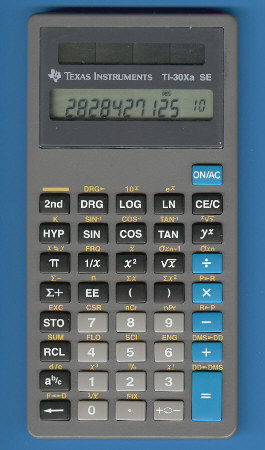
DATAMATH CALCULATOR MUSEUM
 |
DATAMATH CALCULATOR MUSEUM |
Texas Instruments TI-30Xa SE
| Date of introduction: | April 6, 1995 | Display technology: | LCD |
| New price: | $19.95 | Display size: | 10 + 2 |
| Size: | 5.6" x 2.8" x 0.45" | ||
| Weight: | 2.4 ounces | Serial No: | |
| Batteries: | n.a. | Date of manufacture: | mth 06 year 1996 |
| AC-Adapter: | Origin of manufacture: | China (N) | |
| Precision: | 12 | Integrated circuits: | Toshiba T6M79 |
| Memories: | 3 | ||
| Program steps: | Courtesy of: | Joerg Woerner |

![]() Texas
Instruments introduced with the TI-30Xa SE a more robust version of the original
TI-30Xa Solar for school purposes. Compared to
the standard calculator this "School Edition" uses tamper proofed
molded keys instead of the rubber keys and an extra window above the display and
solar cells.
Texas
Instruments introduced with the TI-30Xa SE a more robust version of the original
TI-30Xa Solar for school purposes. Compared to
the standard calculator this "School Edition" uses tamper proofed
molded keys instead of the rubber keys and an extra window above the display and
solar cells.
Everything else is identical to the standard calculator.

 Dismantling
this TI-30Xa SE manufactured in 1996 by Nam
Tai Electronics, Inc. reveals an unusual construction with a mix of two
different printed circuit board (PCB) technologies. A relatively cheap, phenol
type PCB was selected for the keyboard while the single-chip calculator circuit
was bonded in chip-on-board technology direct on a epoxy style PCB. Even 10
years later Nam Tai still preferred this technology, don't miss a later TI-30X
IIS.
Dismantling
this TI-30Xa SE manufactured in 1996 by Nam
Tai Electronics, Inc. reveals an unusual construction with a mix of two
different printed circuit board (PCB) technologies. A relatively cheap, phenol
type PCB was selected for the keyboard while the single-chip calculator circuit
was bonded in chip-on-board technology direct on a epoxy style PCB. Even 10
years later Nam Tai still preferred this technology, don't miss a later TI-30X
IIS.
 Read
more about the Logarithm Bug and its
side effect on the related yx function present in this calculator.
Read
more about the Logarithm Bug and its
side effect on the related yx function present in this calculator.
This calculator got later a new styling like the TI-32 Explorer Plus. View it here.
In 2005 Texas Instruments failed with the TI-30Xa Solar School Edition for Virginia and recalled about 160,000 calculators.
The extension "School Edition" wasn't limited to calculators, in 1987 an electronic toy found its way into the classrooms. Don't miss the wonderful Touch & Discover School Edition.
Stokes Publishing Company, Inc. based in Sunnyvale, California sold a companion for the teacher, view the wonderful Scientific Plus.
Texas Instruments was always listening for the demands of the classroom. The first calculator designed together with the teachers was the TI-30 Galaxy, later the mathematics community defined some other products. Read some guidelines how to select the right calculator to ensure long-term satisfaction:
| • Solar Power: Eliminates the need for batteries. The TI
ANYLITE™ technology allows operation even in low light. • Durability: Plastic keys are tougher and more tamper-proof than rubber keys. An extra window protects the LCD display and the solar cells. • Keyboard: Color coding helps children quickly identify functional key groupings. Large, well spaced keys are easier to find and press. • Packaging: With a convenient storage caddy 10 or even 30 calculators are grouped together. • Functions: Choose a model with only the specific functions you need. Unnecessary functions clutter the keyboard and may impede a student's understanding of the concepts. |
In the year 1995 Texas Instruments provided a total of 6 different calculators (not counting the Graphing Calculators TI-80, TI-81, TI-82 and TI-85) to meet the above demands:
| TI-108 | Math Mate | Math Explorer | Explorer Plus | TI-30Xa SE | TI-34 | |
|
Introduction |
1990 |
1993 |
1987 |
1995 |
1995 |
1987 |
|
Display Digits |
8 |
8 |
8 |
10, 6+2 |
10+2 |
10+2 |
|
Power |
Anylite Solar |
Anylite Solar |
Anylite Solar |
Anylite Solar |
Anylite Solar |
Anylite Solar |
|
General Functions |
|
|
|
|
|
|
|
CE/CA |
* |
* |
* |
* |
* |
* |
|
Backspace |
|
|
* |
* |
* |
* |
|
Fixed Place |
|
|
* |
* |
* |
* |
|
Basic Math Functions |
|
|
|
|
|
|
|
+,-,*,/ |
* |
* |
* |
* |
* |
* |
|
Integer Division |
|
|
* |
* |
|
|
|
Integer |
|
|
|
* |
|
|
|
Operating |
|
AOS |
AOS |
AOS |
AOS |
AOS |
|
Parentheses |
|
1 Level |
8 Levels |
15 Levels |
* |
* |
|
Square Root |
* |
|
* |
* |
* |
* |
|
Square |
|
|
* |
* |
* |
* |
|
Percent |
* |
|
* |
* |
* |
* |
|
Constant |
|
|
|
|
|
|
|
Automatic (=) |
* |
* |
* |
|
|
* |
|
Operation Key |
|
|
1 |
2 |
1 |
|
|
Fraction |
|
|
|
|
||
|
Basic,Frac->Dec |
|
|
* |
* |
* |
* |
|
Dec->Frac |
|
|
* |
* |
* |
|
|
Simplify |
|
|
* |
* |
|
|
|
Math Functions |
|
|
|
|
|
|
|
10n |
|
|
* |
* |
|
|
|
Exponents, yx |
|
|
* |
* |
* |
* |
|
Pi |
|
|
* |
* |
* |
* |
|
x! |
|
|
|
* |
* |
* |
|
Log,Ln,10x,ex |
|
|
|
* |
* |
* |
|
P->R, R->P |
|
|
|
|
* |
* |
|
nPr, nCr |
|
|
|
* |
* |
|
|
DMS->DD, |
|
|
|
|
* |
* |
|
Trigonometry Functions |
|
|
|
|
|
|
|
Sin,Cos,Tan and |
|
|
|
* |
* |
* |
|
Hyperbolics and |
|
|
|
|
* |
* |
|
DRG, DRG-> |
|
|
|
* |
* |
* |
|
1-Variable Statistics |
|
|
|
|
|
|
|
Mean, Sum, |
|
|
|
* |
* |
* |
|
Number Bases |
|
|
|
|
|
|
|
Hex, Oct, |
|
|
|
|
|
* |
|
Boolean Logic |
|
|
|
|
|
* |
|
Memory |
|
|
|
|
|
|
|
Store |
|
|
|
1 |
3 |
3 |
|
Recall |
* |
* |
* |
* |
* |
* |
|
M+ |
* |
* |
* |
* |
* |
* |
|
M- |
* |
* |
* |
* |
* |
|
|
Exch. X<->M |
|
|
* |
* |
* |
* |
If you have additions to the above article please email: joerg@datamath.org.
© Joerg Woerner, December 5, 2001. No reprints without written permission.